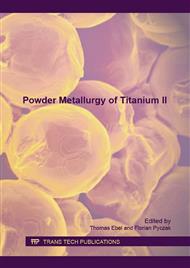[1]
D. M. Robertson, L. Pierre, R. Chahal,. Preliminary observations of bone ingrowth into porous materials. J Biomed Mater Res 10 (1976) 10: 335–44.
DOI: 10.1002/jbm.820100304
Google Scholar
[2]
H. U. Cameron I. Macnab, R. M. Pilliar,. A porous metal system for joint replacement surgery. Int J Artif Organs 1 (1978) 104–9.
Google Scholar
[3]
W. C. Head, D. J. Bauk, R. H. Emerson Jr., Titanium as the material of choice for cementless femoral components in total hip arthroplasty. Clin Orthop (1995) 85–90.
Google Scholar
[4]
G. Ryan, A. Pandit, D. Panagiotis Apatsidis: Fabrication methods of porous metals for use in orthopaedic applications, Biomaterials 2006, 27, 2651–2670.
DOI: 10.1016/j.biomaterials.2005.12.002
Google Scholar
[5]
R. Miyao, O. Mamoru,W. Fumio,Y. Atsuro,M. Hironobu,H. Toshio, K. Takao. Fabrication of functionally graded implants by spark plasma sintering and their properties. J Japan Soc Powder Powder Metall (Japan) 47(11) (2000) 1239–1242.
DOI: 10.2497/jjspm.47.1239
Google Scholar
[6]
F. Watari, H. Kondo, R. Miyao, M. Omori, A. Okubo, T. Hirai, A. Yokoyama, M. Uo, Y. Tamura, T. Kawasaki, Effect of spark plasma sintering pressure on the properties of functionally graded implant and its biocompatibility. J Japan Soc Powder Powder Metall (Japan) 49(12) (2002).
DOI: 10.2497/jjspm.49.1063
Google Scholar
[7]
A. Molinari, M. Zadra, Influence of the sintering temperature on microstructure and tensile properties of Ti6Al4V produced by Spark Plasma Sintering, Proceedings EuroPM2009 Congress and Exhibition, 12-14 October 2009, Copenhagen (Denmark), ed. EPMA, Shrewsbury (UK), vol. 2, pp.267-274.
Google Scholar
[8]
M. Zadra, F. Casari, L. Girardini, A. Molinari, Microstructure and mechanical properties of cp-titanium produced by spark plasma sintering, Powder Metallurgy 51(1)(2008)59.
DOI: 10.1179/174329008x277000
Google Scholar
[9]
H.Q. Nguyen, D.A. Deporter, R.M. Pilliar, N. Valiquette, R. Yakubovich, The effect of sol-gel-formed calcium phosphate coatings on bone ingrowth and osteoconductivity of porous-surfaced Ti alloy implants, Biomaterials 25(2004)865-976.
DOI: 10.1016/s0142-9612(03)00607-0
Google Scholar
[10]
G. M. Hood: Journal of Physics F: Metal Physics, 1976, 6, 19-26.
Google Scholar
[11]
N. Vicente, A. Fedrizzi, N. Bazzanella, F. Casari, F. Bucciotti, A. Molinari, Microstructure of interface of SPS co-sintered and sinter bonded cp2-Ti and Co28Cr6Mo, Powder Metallurgy 56(2)(2913)143-148.
DOI: 10.1179/1743290112y.0000000040
Google Scholar
[12]
S. Yue,R. M. Pilliar, G. C. Weatherly, The fatigue strength of porouscoated Ti–6% Al–4%V implant alloy. J Biomed Mater Res 18 (1984) 1043–1058.
DOI: 10.1002/jbm.820180908
Google Scholar
[24]
D. H. Kohn, P. Ducheyne, A parametric study of the factors affecting the fatigue strength of porous coated Ti–6A1–4V implant alloy. J. Biomed Mater Res 24 (1990) 1483–1501.
DOI: 10.1002/jbm.820241106
Google Scholar
[13]
D. Wolfarth, P. Ducheyne, Effect of a change in interfacial geometry on the fatigue strength of porous-coated Ti–6A1–4V. J Biomed Mater Res 28 (1994) 417–425.
DOI: 10.1002/jbm.820280403
Google Scholar


